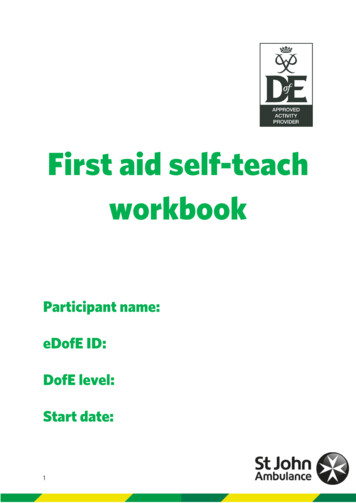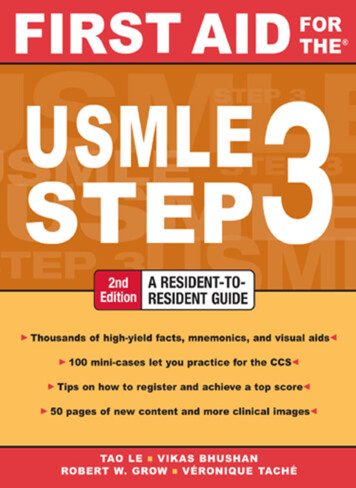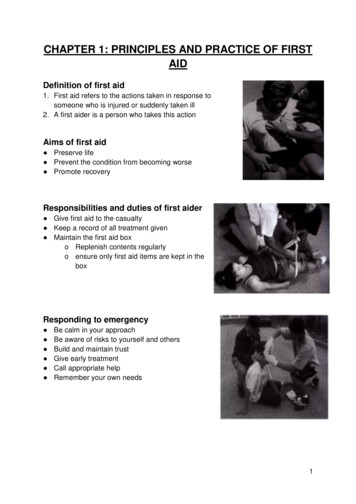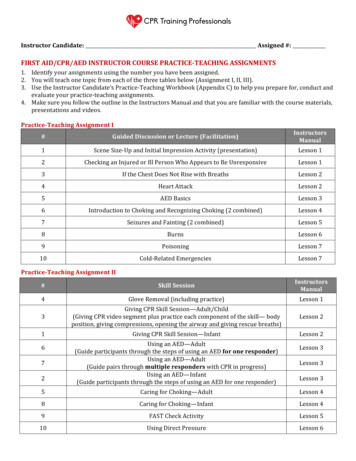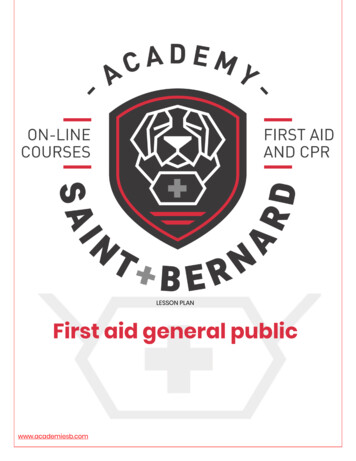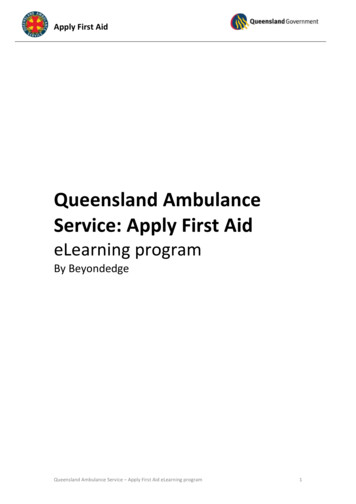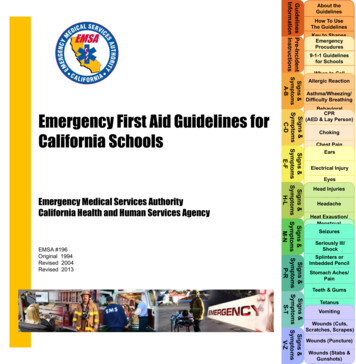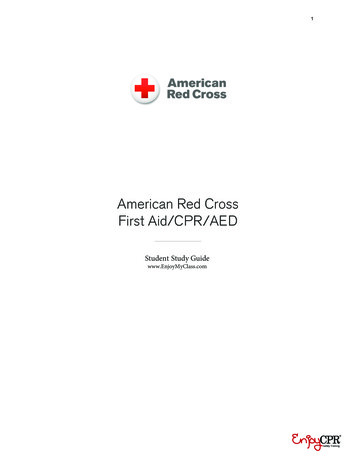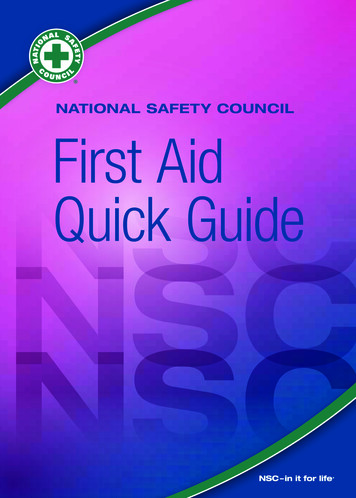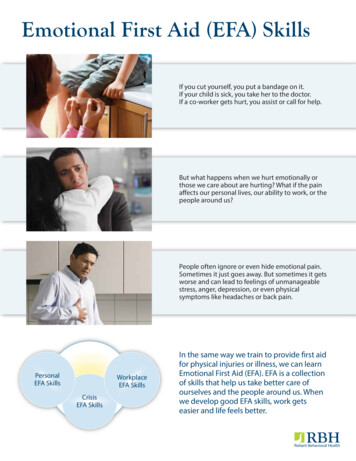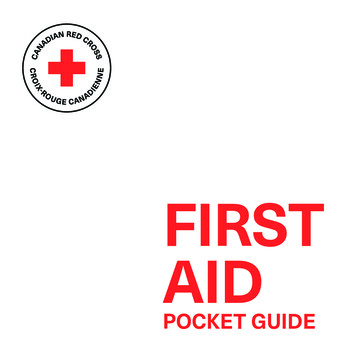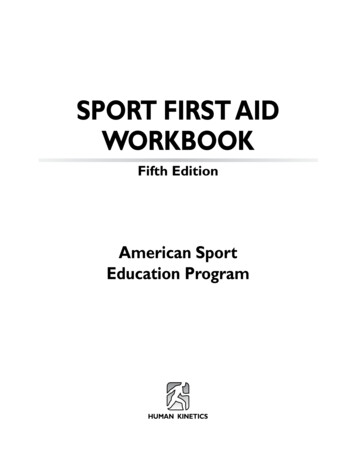
Transcription
Sport First AidWorkbookFifth EditionAmerican SportEducation ProgramHUMAN KINETICS
Sport First Aid Workbook, Fifth EditionISBN-10: 1-4504-6891-8 (print)ISBN-13: 978-1-4504-6891-6 (print)Copyright 2014, 2008, 2004, 1997, 1992 by Human Kinetics, Inc.All rights reserved. Except for use in a review, the reproduction or utilization of this work in any form or by anyelectronic, mechanical, or other means, now known or hereafter invented, including xerography, photocopying, andrecording, and in any information storage and retrieval system, is forbidden without the written permission of thepublisher.Printed in the United States of America10987654321The paper in this book is certified under a sustainable forestry program.Human KineticsWebsite: www.HumanKinetics.comUnited States: Human KineticsP.O. Box 5076Champaign, IL 61825-5076800-747-4457e-mail: humank@hkusa.comCanada: Human Kinetics475 Devonshire Road Unit 100Windsor, ON N8Y 2L5800-465-7301 (in Canada only)e-mail: info@hkcanada.comEurope: Human Kinetics107 Bradford RoadStanningleyLeeds LS28 6AT, United Kingdom 44 (0) 113 255 5665e-mail: hk@hkeurope.comAustralia: Human Kinetics57A Price AvenueLower Mitcham, South Australia 506208 8372 0999e-mail: info@hkaustralia.comNew Zealand: Human KineticsP.O. Box 80Torrens Park, South Australia 50620800 222 062e-mail: info@hknewzealand.comE6158
ContentsPrefacevsport first aid Classroom unitsUnit 1 Introduction to Sport First Aid (23 minutes) . . . . . . . . . . 1Unit 2Your Role on the Athletic Health Care Team(15 minutes) . . . . . . . . . . . . . . . . . . . . . . . . . . . . 7Unit 3 Types of Injuries (20 minutes) . . . . . . . . . . . . . . . . . 13Unit 4Emergency Action Steps (50 minutes) . . . . . . . . . . . . 21Unit 5 Physical Assessment and Providing ImmediateFirst Aid (60 minutes) . . . . . . . . . . . . . . . . . . . . . . 35Unit 6Moving Injured or Sick Athletes (10 minutes) . . . . . . . . . 49Unit 7Head, Spine, and Nerve Injuries (20 minutes) . . . . . . . . . 53Unit 8Musculoskeletal Injuries (35 minutes) . . . . . . . . . . . . . 59Unit 9Sport First Aid Wrap-Up (16 minutes) . . . . . . . . . . . . . 69iii
PrefaceWelcome to the Sport First Aid classroom course! The goalof this course is two-fold: to inform you on the best practicesto help you’re athletes avoid athletic injuries and to help youbecome an effective first responder when one of your athletesgets injured or becomes ill. The classroom course and test preparation activities are designed to help you learn what steps youshould take to become confident in responding to your athletes’injuries and illnesses.The Sport First Aid Workbook is your guide and resource forcompleting the two activities mentioned previously: classroomcourse and test preparation activities. You’ll use it during theclassroom course as your instructor leads you through activities, videos, and discussions. All of the resources you need forthe classroom course are in the workbook, and plenty of spacehas been left for you to write notes at the end of each unit.After you’ve completed the classroom course, you’ll use thetest preparation assignments to prepare for the Sport First Aidtest. These assignments include reading the course text, SportFirst Aid, and working through the units in the Sport First AidOnline Component. Attending the classroom course, reading thetext, and completing the online component should prepare youfor the Sport First Aid test. Just as important, these activitiesshould enhance your ability to be an effective sport first aiderfor the athletes you coach.ASEP hopes that you find the course and supporting resourcesvaluable in contributing to your efforts to be a successful coach.We wish you the best of success in providing meaningful sportexperiences for your athletes.v
Unit1Introductionto Sport First Aid(23 minutes)Purpose: To introduce you to the Sport First Aid course, includ-ing the course purpose, learning objectives, agenda, and resources.Learning ObjectivesIn this unit, coaches will learn about the course resources; the purpose, learning objectives, and agenda for the SportFirst Aid course; and the procedures for completing the test preparation and testphases of the course.Unit OverviewTopicActivitiesTime (minutes)A. Welcome and IntroductionsCourse welcomeCourse resources10B. Overview of the Sport First AidCoursePurpose, objectives, and agenda for the course3C. Completing the CourseSection introductionProcedures for completing the test preparationand test phases of the courseHousekeeping detailsUnit summary and the learning environment101
2 Sport First Aid WorkbookUnit ContentA Welcome and Introductions(10 minutes) Be prepared to introduce yourself by giving your- name,- present position,- sports coached, and- length of career.Course Packages The course text, Sport First Aid, or, alternatively, a key codeletter (included in the test package) with the key code toaccess the Sport First Aid e-book Sport First Aid Workbook A Sport First Aid classroom test package that includes thefollowing:- Sport First Aid classroom test- ASEP Test Answer Form A to record test answers- Sport First Aid test instructions- Preaddressed ASEP mailing envelope for the coach tomail the completed ASEP Test Answer Form A- Cardboard insert to ensure that the test form is notdamaged in the mail- Key code letter with the key code to access the SportFirst Aid Online ComponentSport Fist Aid Workbook Each unit includes the following:- Unit’s purpose, learning objectives, overview, and sections (A, B, and so forth)- Summary of the unit introduction- For every activity: an introduction; instructions thatdescribe the resources to use, steps to complete, andthe outcome of your work; and activity worksheets foryou to write on to complete the activity- In the workbook: space for you to write notes at theend of each unit. This space is denoted with the word“notes” in parentheses.
Introduction to Sport First Aid 3Sport First Aid The first few chapters of the Sport First Aid book contain general information for you as a coach and as a first responderin injury and illness situations. Chapters 4 and 5 cover the emergency action steps andphysical assessment, which we’ll be spending a lot of timeon during this course. Chapter 6 describes how to move an injured or ill athlete. Chapters 7 through 15 list injuries and illnesses that youmight encounter as a coach, with corresponding symptomsand signs for easier recognition and appropriate first aidsteps for you to take.Test Options You can complete the course test using a paper–pencilform, or you can complete it online. Everything you’ll need to do for either test is described inthe Sport First Aid test instructions booklet.Test Information If you take the paper–pencil test, you’ll enter this information on the answer form. If you take the online test, you’ll enter this informationonline.REFER to the Test Information form on page 72 in the SportFirst Aid Workbook, and ENTER the information described bythe instructor.B Overview of the Sport First Aid Course(3 minutes)The purpose of the Sport First Aid course is to help you learnthe skills you need to be a competent first responder to players’injuries and illnesses. This course has been designed to help you develop a basic knowledge of sport injuries and illnesses, recognize signs and symptoms of common sport injuriesand illnesses, administer appropriate sport first aid, and learn to use the Sport First Aid book as a reference tool.
4 Sport First Aid WorkbookSport First Aid Classroom Course AgendaUnit numberUnit titleTime (minutes)1Introduction to Sport First Aid232Your Role on the Athletic Health Care Team153Types of Injuries204Emergency Action Steps50Break(In two-day format, may stop first day here.)105Physical Assessment and Providing Immediate First Aid606Moving Injured or Sick Athletes107Head, Spine, and Nerve Injuries208Musculoskeletal Injuries359Sport First Aid Wrap-Up16total time:4 hours,15 minutes(not includingbreaks)C Completing the Course (10 minutes)Course Topics For the first couple of hours today, we will discuss yourrole on the athletic health care team, types of injuries andillnesses, and how to conduct emergency action steps. Then we’ll take a 10-minute break. We’ll finish up the day by learning how to conduct a physical assessment, control bleeding, minimize shock, applysplints and compression wraps, move an injured or illathlete, provide first aid care for head and spine injuries,and handle musculoskeletal injuries. Before you head home, we’ll wrap things up and discusshow you can use the book, the workbook, and the onlinecomponent to prepare for the Sport First Aid classroomtest.
Introduction to Sport First Aid 5Test Preparation and Test Procedures Over the next several weeks, you need to complete theother phases of Sport First Aid—the test preparation phaseof the course and the Sport First Aid test.- The steps for completing the test are described in theSport First Aid test instructions included in your testpackage.- You should plan to complete these activities by.- If you do not successfully pass your Sport First Aid testwithin one year of the last date of your course (today),you will have to take the entire course over again andpay all of the course fees again. Before you take the test, you should read Sport First Aidand complete the related activities included in the onlinecomponent.- Instructions for accessing the Sport First Aid OnlineComponent are included on the key code letter in yourcourse package.- All of the activities we complete today and all of theactivities you complete during the test preparationwill help you become effective coaches and will helpyou pass the test. However, do not fail to carefully readevery chapter in Sport First Aid because all of the testquestions are based on content in the book. The last thing you’ll do to complete the course is to complete the course test.- You can complete the paper–pencil test, or you cancomplete the test online.- The instructions and forms you’ll need to complete thecourse test are included in this Sport First Aid classroom test package.- The package contains the Sport First Aid test instructions, which provide a detailed description of what youneed to do to complete the course test. After readingSport First Aid and completing the related online activities, you really have only three things to do:1. Decide whether you’ll complete the paper–pencil testor the online test.2. Complete the test.3. Get your test scored.
6 Sport First Aid Workbook At the end of the course today, we’ll discuss things youshould consider in deciding whether to take the paper–pencil test or the online test. Whichever test you take, it’s important to remember thefollowing:- The course test is open book. You can refer to Sport FirstAid and any other course materials while you completethe test.- You should complete the test individually unless theinstructor tells you otherwise.- If you do not pass the test the first time, you can take itagain. The procedures for taking a retest are describedin the test instructions.- If you complete your first test paper–pencil, you mustcomplete retests in the paper–pencil format. If you complete your first test online, you must complete retestsin the online format.The Learning Environment Feel free to ask questions at any time. There are no dumbquestions. Be assertive about what you need to understandsport first aid better. Use the workbook in whatever way makes it easier for you tolearn. Take notes, make check marks, underline importantthings—do whatever you need to do to make it a worthwhileresource. Relax. Enjoy yourself. Be open. Participate. We’re all hereto learn together.(Notes)
Unit2Your Role on theAthletic Health Care Team(15 minutes)Purpose: To introduce you to your role in working on theathletic health care team and teach you how to prepare a sportfirst aid game plan.Learning ObjectivesIn this unit, you will learn about the athletic health care team and your role on it and how to develop a sport first aid game plan.Unit OverviewTopicActivitiesTime (minutes)A. Unit IntroductionHear about the unit’s purpose,objectives, and agenda.1B. Coach’s Role on the Athletic Health Care Teamand How to Develop a Sport First Aid Game PlanWatch a DVD segment, “Your Roleon the Athletic Health Care Team.”5C. Evaluating Your Sport First Aid Game PlanFill out Chapter 2 Replay on page 28of Sport First Aid.8D. Unit SummaryReview key unit points.17
8 Sport First Aid WorkbookUnit ContentA Unit Introduction (1 minute) Your role on the athletic health care team and how to prepare a sport first aid game plan What you need to do to complete a sport first aid gameplan for your particular situationB Coach’s Role on the Athletic HealthCare Team and How to Develop aSport First Aid Game Plan (5 minutes)On the DVD Segment, “Your Role on theAthletic Health Care Team” Legal definitions of your role as a coach Parental expectations Other members of the athletic health care team Playing it safe with return to play, including the importanceof treatment and rehabilitation How to develop a sport first aid game planC Evaluating Your Sport First AidGame Plan (8 minutes)Activity 2.1 Evaluating Your Sport First AidGame PlanIntroductionYou heard on the DVD segment that to be prepared for emergencies, you need to develop a sport first aid game plan. Thisinvolves collecting health records of your athletes, creating aweather emergency plan, preparing a medical emergency plan,and so forth. For the next few minutes, you’ll evaluate what you need todo in your particular coaching situation to complete yoursport first aid game plan. When you complete the self-study portion of this course,you’ll actually complete your own sport first aid gameplan.
Your Role on the Athletic Health Care Team 9ResourcesChapter 2 Replay from the Sport First Aid book Do you regularly study sports medicine literature andattend sports medicine seminars? (pp. 13-14) Are you currently certified in CPR? (p. 14) Have all of your athletes filled out an informed consentform for emergency medical treatment, a health historyform, and an emergency information card? (p. 14) Have you prepared and implemented a weather emergency plan? (pp. 15-17) Do you regularly inspect the condition of playing areasand equipment? (pp. 17-20) Do you find and repair any defects in playing equipmentbefore the start of each season? (pp. 17-20) Do you have a well-stocked first aid kit? (pp. 17, 20) Do you require athletes to undergo extensive physicalexaminations and preseason screening to pinpoint anypotential health or fitness problems? (p. 21) Do you have a preseason conditioning plan, and doyou incorporate warm-up and cool-down exercises intoevery practice and competition to help prevent injuries?(pp. 21-22) Do you enforce policies that require athletes to wearprotective equipment and refrain from physical horseplay? (pp. 22-25) Do you teach athletes correct sport skill techniquesand repeatedly warn them against techniques that arepotentially dangerous? (p. 23) Do you provide sound nutritional guidance, sufficienthydration, and nutritional eating opportunities? (pp.23-25) Have you developed an emergency plan, including whois responsible for what duties, how a duty should becarried out, when certain actions should be taken, andwhat paperwork needs to be completed? (pp. 25-27)Instructions1. Work in pairs.2. Talk through the checklist together.3. Check off the items that you’ve already accomplished inyour particular coaching situation and note the steps thatyou need to complete in the margins of your workbook.
10 Sport First Aid Workbook4. Complete the checklist for your situation only, but discusseach item with your partner. You may gain insights fromeach other about how to efficiently complete certain partsof the sport first aid game plan.5. You probably won’t get through the entire checklist in thetime allotted, and that is all right. Complete as much ofthe checklist as you can now, and then you can finish iton your own later.6. Take 7 minutes to complete your work.Activity OutcomeWhen you’re done, you should have completed as much of thechecklist as possible. The items that you have already completedin your coaching situation should have a check mark next tothem, and you should have a good sense of which steps youstill need to take care of.D Unit Summary (1 minute) Along with many other legal duties, you have a legal obligation to provide emergency medical assistance. Parents expect you to provide a safe environment for theirchildren. They expect you to have some knowledge of sportfirst aid and to know where to refer them for more information. You should develop good working relationships with othermembers of the athletic health care team and support theirdecisions regarding treatment and rehabilitation. Players who are injured or sick can return to play only afterall symptoms and signs have subsided or after examinationand release by a physician. A sport first aid game plan includes gathering healthrecords for each athlete, developing a weather emergencyplan, checking facilities for hazards, checking equipment forproper fit and usage, stocking a first aid kit, arranging forpreseason physicals and fitness screenings, incorporatingconditioning into your program, and developing a medicalemergency plan. Use the forms provided in chapter 2 of Sport First Aid toguide you in preparing for emergencies.
Your Role on the Athletic Health Care Team 11(Notes)
Unit3Types of Injuries(20 minutes)Purpose: To help you learn how to recognize the main typesof acute and chronic injuries.Learning ObjectivesIn this unit, you will learn how most injuries occur, what distinguishes acute and chronic injuries, and how to recognize the main types of acute and chronic injuries.Unit OverviewTopicActivitiesTime (minutes)A. Unit IntroductionHear about the unit’s purpose, objectives,and agenda.1B. Types of Injuries and How They OccurFill out a table while watching the DVDsegment, “Types of Injuries and How TheyOccur.”9C. Injury CausesIn teams, complete mechanisms (injurycauses) columns in a table. Points will beawarded for correct answers.9D. Unit SummaryReview key unit points.113
14 Sport First Aid WorkbookUnit ContentA Unit Introduction (1 minute) Causes of injury Acute injuries Chronic injuriesB Types of Injuries and How They Occur(9 minutes)Activity 3.1 Types of InjuriesIntroductionKnowing how an injury occurred and whether it occurred suddenly or over time may help you to correctly identify an injuryand respond with appropriate first aid care. In this activity, you’llfill out a table as we watch a DVD segment.Resources The table, Examples of Injuries That Affect Specific BodyTissues. (This table is provided on page 15.)Instructions1. Work individually.2. As you watch the DVD segment, listen fora. what types of injuries affect different body tissuesandb. whether an injury is acute or chronic.3. Fill in the table as you watch the DVD segment.a. In the second column, write the types of injuries thatcan affect each body tissue. For example, you’ll hearon the DVD segment that bones can sustain closedfractures, so you would write Closed fracture in thesecond column.b. In the third column, write Acute if the injury occurs suddenly and is theresult of a specific injury mechanism, write Chronic if the injury develops over a period ofseveral weeks and is typically caused by repeatedinjury, or write Acute or Chronic if both could be the case.
Examples of Injuries That Affect Specific Body TissuesTissueInjuryType of injuryBoneClosed nEyeOther organs (heart,kidney, and so forth)15
16 Sport First Aid WorkbookFor example, bones can sustain closed fractures. Closed fractures occur suddenly, so you would write Acute in the thirdcolumn. As you can see, the answers for this injury have beenprovided in the table as an example.Activity OutcomeWhen you’re done, you should have completed the “Injury” and“Type of injury” columns in the table. We’ll review the resultsafter watching the DVD segment.C Injury Causes (9 minutes)Activity 3.2 Injury CausesIntroductionAs explained on the DVD segment, injuries are usually causedby one of three mechanisms: compression, tension, or shearing. In this activity, you’ll learn what mechanisms often causewhich injuries.Resources The table, Injuries and Their Mechanisms. (This table isprovided on page 17.)Instructions1. Work in teams of four if possible.2. Work with your team to decide which mechanisms cancause each injury listed in the table.3. Place an X in the column if that mechanism can causethe injury. For instance, if compression can cause acontusion, place an X under Compression and across fromContusion.4. You may place more than one X in a row. That is, someinjuries can be caused by several different mechanisms,and you should place an X under each of those. Otherinjuries may be caused by only one mechanism.5. You will have 6 minutes to complete the table. You’ll needto work quickly.6. At the end, we will award points for correct answers andsee which team won the challenge.Activity OutcomeWhen you’re done, you should have completed the table with Xsin the columns that match the injuries with their mechanisms.
Injuries and Their MechanismsAcute onsLacerationsIncisionsSprainsAcute strainsCartilage tearsDislocations and subluxationsBone fracturesEpiphyseal fracturesChronic injuriesBursitisTendinosis, tenosynovitis, and paratendinitisStress fractures17
18 Sport First Aid WorkbookD Unit Summary (1 minute) Injuries are often caused by one of three mechanisms:compression, tension, or shearing. Injuries can be distinguished by the time it takes for themto develop.- Acute injuries occur suddenly as a result of a specificinjury mechanism.- Chronic injuries develop over a period of several weeksand are typically caused by repeated injury. Knowing which mechanism caused an injury and knowingwhether the injury occurred suddenly or over time mayhelp you to correctly identify an injury and respond withappropriate first aid care.(Notes)
Unit 3 Activity OutcomesExamples of Injuries That Affect Specific Body Tissues—Activity 3.1 OutcomeTissueInjuryType of injuryBoneClosed fractureOpen fractureAvulsion fractureOsteoarthritisStress fractureAcuteAcuteAcute or chronicChronicChronicCartilageTearContusionAcute or chronicAcuteLigamentSprainAcuteMuscleStrainAcute or tureAvulsion (example: ear lobe)AcuteAcuteAcuteAcuteAcuteEyePunctureAbrasion (corneal)AcuteAcuteOther organs (heart,kidney, and so forth)PunctureContusionAcuteAcuteInjuries and Their Mechanisms—Activity 3.2 OutcomeAcute ringXLacerationsXIncisionsXXSprainsXAcute strainsXCartilage tearsXDislocations and subluxationsXBone fracturesXEpiphyseal fracturesXXXXXXXChronic injuriesBursitisTendinosis, tenosynovitis, and paratendinitisStress fracturesXXX19
Unit4Emergency Action Steps(50 minutes)Purpose: To help you learn how to perform the emergencyaction steps and the Heimlich maneuver.Learning ObjectivesIn this unit, you will learn what to do first when an athlete goes down due to injuryor illness, how to perform the emergency action steps, how to recognize and respond to an airway blockage, what to do if an athlete stops breathing, and why learning CPR and AED is critical for a coach.Unit OverviewTopicActivitiesTime (minutes)A. Unit IntroductionHear about the unit’s purpose, objectives, and agenda.1B. Emergency Action Steps fora Responsive AthleteWatch a DVD segment, “Performing the EmergencyAction Steps.” In groups of three, practice theemergency action steps for a responsive athlete.18C. Emergency Action Steps foran Unresponsive AthleteIn pairs, practice the emergency action steps for anunresponsive athlete.15D. Airway BlockageWatch a DVD segment, “Airway Blockage.” In teams,practice first aid for airway obstructions in responsiveathletes, including the Heimlich maneuver.14E. Unit SummaryReview key unit points.221
22 Sport First Aid WorkbookUNIT CONTENTA Unit Introduction (1 minute) How to perform the emergency action steps for a responsiveathlete How to perform the emergency action steps for an unresponsiveathlete How to recognize and respond to an airway obstructionB Emergency Action Steps for a ResponsiveAthlete(18 minutes)On the DVD Segment, “Performing theEmergency Action Steps” Assessing the scene and the athlete Alerting EMS (or emergency action plan) Attending to the athlete’s breathingActivity 4.1 Emergency Action Stepsfor a Responsive AthleteIntroductionYou heard on the DVD segment what the emergency action steps are.In this activity you’ll practice following those steps for a responsiveathlete. To complete the activity, you’ll need to know a little aboutfirst aid for a lower leg fracture. This and other illnesses and injuriesare covered in the Sport First Aid book.The Sport First Aid book includes a reference guide for over 110sport injuries and illnesses. The description of most of these injuriesand illnesses begins with four sections that will help you identifythe injury or illness. These sections are as follows: Definition Causes Ask if Experiencing Symptoms Check for SignsYou’ll also use the Sport First Aid Emergency Action Steps onpage 28.
Emergency Action Steps 23The emergency action steps are a one-stop guide to performing the steps, whether the athlete is responsive or unresponsive.It includes steps you should follow to determine if the athlete is responsive, check breathing, and follow up with appropriate first aid care.Resources The Athlete, Coach, and Observer Scenarios. (These areprovided after the following instructions and activity outcome.) Chapter 13 in Sport First Aid The Sport First Aid Emergency Action Steps located on page28Instructions1. Work in groups of three. One person will be the athlete,one person will be the coach, and one person will be anobserver.2. When the activity starts, do the following:a. Select which role each of you will play.b. Spend a minute preparing for your roles. If you’re the athlete, read through the Athlete Scenario (see page 24) and be prepared to respondappropriately. If you’re the coach, read through the Coach Scenario (see page 24). You should also have chapter13 of Sport First Aid open to refer to, as well as theEmergency Action Steps. If you’re the observer, read through the ObserverScenario (see pages 24 and 25), which you will useto evaluate the role play.3. Start the role play.4. After completing the role play, discuss with your groupthe emergency action steps that you would take.5. You’ll have 8 minutes to complete this activity.Activity OutcomeWhen you’re done, your group should have completed one roleplay. You will have practiced performing the emergency actionsteps for a responsive athlete.
24 Sport First Aid Workbook thlete Scenario - - - - - - - - - - - - - - - - - - - - - - - - - - - - - -You’re a gymnast who’s fallen off a balance beam and brokenyour leg. Your leg hurts, and you heard a “pop” when you landed.There is swelling in the leg, and the leg’s skin color is somewhatbluish. You try to move a bit when the coach arrives. Coach Scenario - - - - - - - - - - - - - - - - - - - - - - - - - - - - - -You’re supervising a gymnastics workout when you see one ofyour athletes fall off the balance beam with a “thud.” She is lyingon the floor and grimacing in pain, and you see her teammatesgathering around her.To take the emergency action steps, do the following:1. Assess the scene.2. Assess the athlete.3. Alert EMS or your emergency action plan.4. Attend to the athlete.Say out loud what you’re doing as you do it. Observer Scenario - - - - - - - - - - - - - - - - - - - - - - - - - - - - -Your role is to evaluate if the coach took the correct actionsfor each step. Use the following checklist to check off items thecoach completes.Assess the Scene Move all other players and bystanders away. Consider if the environment is safe. Do you need tomove the ill or injured athlete because conditions aredangerous? Calm the athlete and keep him or her from moving. Consider if you need to roll the athlete over or removeequipment in order to evaluate his or her condition orprovide first aid.Assess the Athlete Review in your mind how the injury or illness occurred. Review in your mind the athlete’s medical history, if youknow it. Check the responsiveness of the athlete by gently tapping or squeezing his or her shoulder and by asking “Areyou all right, (athlete’s name)?”
Emergency Action Steps 25Alert EMS If your assessment indicates a condition that requiresmedical attention, have someone call 9-1-1 or activateyour emergency action plan.Attend to the Athlete Identify yourself (if the athlete doesn’t know you) andask the athlete’s permission to help. Make sure the athlete is fully responsive and is breathingnormally (if not, begin CPR). Look for and control any severe bleeding with directpressure. Look for normal tissue color and body temperature. While waiting for medical assistance, continue to attendto breathing, control bleeding, and monitor tissue colorand body temperature. Continue to control bleeding, monitor tissue color andtemperature, and help maintain the athlete’s normalbody temperature.C Emergency Action Steps for anUnresponsive Athlete(15 minutes)Activity 4.2 Emergency Actio
First Aid Workbook, and ENTER the information described by the instructor. B overview of the Sport First Aid Course (3 minutes) The purpose of the Sport First Aid course is to help you learn the skills you need to be a competent first responder to players’ injuries
